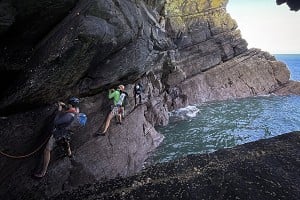
On Tuesday 7th April 45 year-old Devon-based runner Patrick Devine-Wright set off on an attempt to break the speed record for the South West Coast Path. One of the best and hardest, not to mention by far the longest, of Britain's long distance trails, the 1100km (630 mile) route hugs the cliffy coastline all the way from Minehead to Poole, with nearly 36,000m of ascent along the way. Patrick's schedule aims to knock at least one day from the current record of 14 days, 14 hours and 44 minutes. It'll mean running the equivalent in distance of two marathons each day, for the best part of two weeks. Having finished third in the 2012 Dragon's Back race along the mountain spine of Wales, he is no stranger to epic cross country runs - but he's never undertaken anything this huge before. We asked him to tell us more, and about the three charities that he's raising money for.
What’s your background in serious distance running – any big achievements prior to the Dragon’s Back?
I have been competing regularly since school days and have a number of national cross-country medals from my teenage years for team competitions. I was selected for the national junior squad for the 1988 World Mountain Running Championships in the Lake District. And my road marathon PB (personal best) of 2:47 was set in Dublin in 2011, aged 41.
The 2012 Dragon's Back was a five-day race from the top to the bottom of Wales, hills all the way (see race report here). Finishing third with a superb time of just over 49hrs is quite some feat: can you tell us a little about that race, what prompted you to enter in the first place, and how you found it?
It was a step into the unknown for me, and I entered only because friends were entering and I thought it would be fun to join them and try something new. I had no idea how it would go, but was pleasantly surprised at how well it went. Training went well in the run up to the event in terms of avoiding injuries. I was very inexperienced in multi-day events – only one 2-day mountain marathon experience under my belt. I was compelled to enter a three+ day event in the run up to the event by the DB organisers, on experience grounds, and duly came 3rd in the Great Lakeland 3 Day event in May 2012. This showed I could run well for three days in the mountains and navigate reasonably well in unfamiliar terrain under competitive conditions. Funnily enough, I spent the summer before the race in Australia on a sabbatical work trip so virtually none of my running in the final four months was in mountain environments or in the UK, just regular trail running on hilly forest trails. I was not able to do any pre-race recce-ing like other competitors. But it didn’t seem to do me much harm!
The race itself was tough but also great fun. Day one was brutal, due to heat, distance and especially climbing. But it was also fun to run with Helene Whitaker (a legend in fell running circles) in the later stages of day one, including across Crib Goch, which I was surprised to find was more scary for her than myself! I was unsure whether I would be able to continue on day two because of exhaustion and dehydration, but recovered well with food and rest and enjoyed the rest of the week’s running hugely, with a great community spirit amongst all the competitors, particularly our Spanish visitors, many of whom had been timed out on day one but spent the rest of the week determined to enjoy themselves! I also ran most of the last four days with a small group of runners occupying 3rd-7th places, including Helene and Jim Mann (who went on to set a new winter Bob Graham Round record in 2013) and we helped each other out in many ways by keeping each other company. As the days went on, it was about managing fatigue, numerous small niggles and pains but still running well and making it to the finish in one piece.
Is it helpful, psychologically, to have that DB result in the bank now you’ve set your sights on the SWCP record?
Absolutely – I know I can recover quickly from long hard days out when I can access good food and restful conditions. I know that I can run well over consecutive days. What I don’t yet know is how I will manage over a much longer distance and much larger time frame of 12-14 days consecutively … that is the big leap into the unknown in this challenge.
Instead of racing alongside others, as on the DB, with the SWCP you’ll be on your own against the clock: how different is that as an experience?
Very different in some ways, but I am used to this from training and will be accompanied at all times by support drivers who will meet up with me along the way. So I won’t be too much on my own at all. I will also run mindful of all those who have donated funds to my three charitable causes (see below) and keep them in mind as I go along.
It’s a fabulous path: what has attracted you personally to this particular challenge? (Nb. for lesser mortals this UKH Route Card gives a flavour of one of the tougher sections)
It is local to me and I value getting to know where you are, as much as exploring distant places. It is one of the most spectacular stretches of coastline in the world, so it will be a privilege to get to know it better. Most of it will be new to me and I love exploring new routes and places to run. It’s really just a sightseeing holiday! I have been asked many times since 2012 when I will have a crack at a Bob Graham Round (in the Lake District), but it seemed to me more appropriate to try my hand at local challenges on my doorstep before getting too worked up about those elsewhere in the country, or internationally (e.g. the Ultra Tour de Mont Blanc).
So how much of the route will actually be new ground?
Pretty much all of Cornwall and some of the South Devon coast will be new to me, as will later stages in Dorset. Again, I am seeing this as a positive and will enjoy exploring new places.
The SWCP is renowned as a hard walk, very comparable to long distance trails in ostensibly more hilly areas, and with a lot more ascent than people might think: as a challenge, how does it compare to the DB?
It's less of a navigational challenge, and less of mountain challenge, but with massive amounts of small climbs overall and just a huge, huge distance. Will my mind and body be able to stay the course, before bits start falling off…?!
You've a massive 630 miles and 35,000m+ ascent to take on, and a time of 14 days 14 hrs to beat: how confident are you that you’ll be able to pull it off?
Reasonably confident, as far as one can be in a situation like this. Following the DB run in 2012, I have continued to run ultra distances, and well. In 2013, I finished 2nd in the Brecon Beacons race series with several races in the 40-50 mile region. In 2014, I broke local records for the East Devon Way (40m) and East Devon Round (72m) and finished 2nd in my first 100 mile race (Cotswold Century) in just under 20 hours. So I think I have plenty of endurance in my legs.
But this is a step up again – any one of many single issues could scupper my plans: poor weather, a fall, bad blisters, poor nights sleep (I am staying in other people’s houses along the way and moving from one bed to another each night could make resting more difficult) and quality of food for recovery.
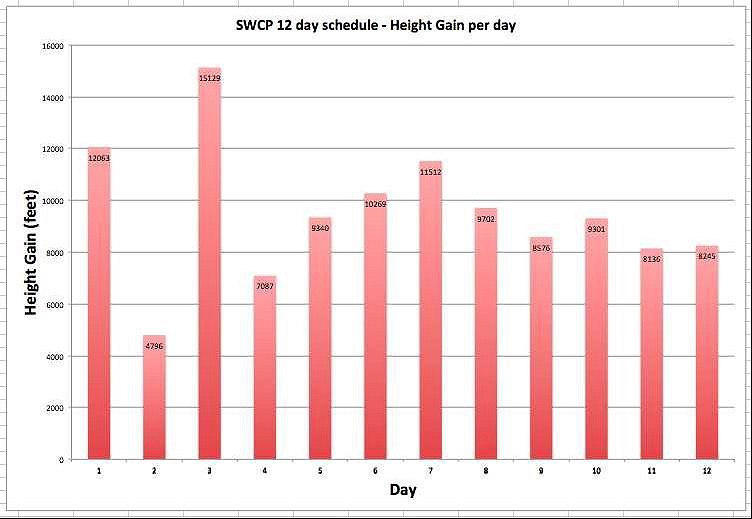
What are your tactics going to be?
Having good kit is vital and I will be very careful about what clothing and shoes I wear – concentrating upon lightweight wind and waterproof clothes and keeping moving continuously – although probably walking the steep climbs. I will bring several pairs of shoes: a grippy pair for mucky conditions and a more cushioned pair for the roadier sections of the route. I may also bring a pair one size too big in the expectation that my feet will expand considerably into the second week as a result of the high mileage (as they did during the DB race). I am lucky to receive support from Patagonia (Ireland) whom I used to work for when I lived in Dublin as a student 25 years ago! They make excellent technical gear for trail and mountain pursuits and I will be putting this kit severely to the test.
I am also thinking very carefully about nutrition as the potential for ‘energy deficit’ (i.e. using more fuel than I take on) into the second week could be disastrous. Apparently, I will burn 5-6000 calories each day so will have to do a fair amount of eating just to stay at parity! In the DB race, I consumed less food than other competitors chiefly because of a habit to eat less during the day whilst running. A science nutrition study was conducted in parallel with the race that showed I ate about 65% of the food of other competitors - I don’t think this will be viable on a 12 day, 600 mile endurance feat, so have had to train myself a bit over the last few months to eat more than normal as I go along on long runs of 4-7 hours.
I am fortunate to have received support from a wholefood shop in my part of the country called Ganesha Wholefoods who have kindly agreed to supply me with staples such as porridge, dried fruit and nuts, bars, snacks etc. The provision of whole foods will help a lot as generally, I avoid gels and supplements of all kinds. I will also eat a lot of soup (perhaps once in the middle of each day and once up finishing each day) as I found during the DB race that this was a great way to stay warm and digest nourishing foods more easily. I will then eat a ‘main meal’ later in the evening, and then a snack before bed.
In terms of routine, I aim to eat breakfast around 7am each morning, then pack up and travel to the run start for each day for an 8am beginning to each day’s run. Then I'll keep going til around 5-6pm depending upon how things go. I will then aim to rest as much as possible each evening, in between eating, and go to sleep by around 9.30pm – if I am not too sore to rest!
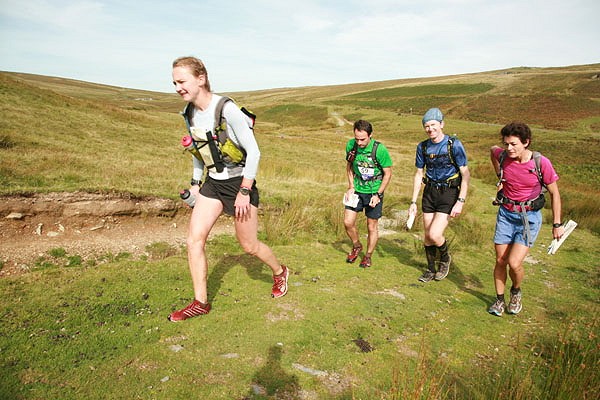
What kind of logistical support will you be getting?
To avoid having to carry much in the way of clothing, food and drink – and travelling as lightly as possible is a constant element of all of my running pursuits – I will be accompanied all the way by someone in a car who is carrying my kit and food bags. This means that I can replenish food and drink every couple of hours. I am very lucky to have people who have volunteered to help me for several days at a time all along the way. Hopefully, we will coordinate well and not miss each other or get lost!
What keeps you motivated when you’re putting in so many lonely miles on a long distance route such as this?
I just love to run so as long as weather conditions are reasonably kind, I will gain huge enjoyment just from being out there in spectacular coastal settings. I also was brought up by the sea in Ireland and always enjoy being in that kind of environment. There is always something to capture your attention – waves crashing on the rocks, impressive cliffs, the call of sea birds, the feel of the sea breeze, the sight of ships on the horizon.
Now you’ve gone so public, with a slot in The Guardian, I guess it has become a concrete reality, and you’re pretty much committed: how does that feel?
Different! This is the most public run I have ever done. The Guardian blog has put out a lot of ripples and I have also been interviewed on BBC Radio. I both like this and feel quite ambivalent about it. It does increase the pressure to ‘deliver’ a little bit, but I would also like to make it a very positive aspect of the run, by encouraging others to enjoy this beautiful path, to get outdoors and exercise, to try something new, perhaps even to take up running!
What sort of training have you been putting in, and how’s that going?
A lot of longer, slower paced runs since December basically, all off road to save my legs. For example a 25 miler during the week and a 35-40 miler at the weekend, or two 35 milers back to back on Saturday and Sunday. I have put in more long runs for this than ever before, and although coming close a few times, I have avoided any problematic injuries, so I hope I have enough in the tank to go the distance.
And finally, could you tell me a little about the charities you’re supporting, and why you’ve chosen them in particular?
I wanted to keep it local and I wanted to share it out amongst different good causes. In the end, I have three charities representing Land, Air and Sea:
- The land one is the South West Coast Path Association, a charity that looks after the coastal path in terms of maintenance each year.
- The Air charity is the Devon Air Ambulance Trust – and I hope I don’t need it myself at any stage!
- The Sea charity is The Wave Project, which started off down in Cornwall and works to reduce anxiety and increase self-confidence in children through water sports training.
You can follow Patrick's progress on Twitter @barefoot_pdq. To make a donation go here
- INTERVIEW: Exmoor Coast Traverse - England's Best Kept Mountaineering Secret 10 Apr
- REVIEW: Rab Muon 50L Pack 9 Apr
- REVIEW: Boreal Saurus 2.0 22 Mar
- REVIEW: The Cairngorms & North-East Scotland 1 Mar
- REVIEW: Mountain Equipment Switch Pro Hooded Jacket and Switch Trousers 19 Feb
- Classic Winter - East Ridge of Beinn a' Chaorainn 12 Feb
- REVIEW: Salewa Ortles Ascent Mid GTX Boots 18 Jan
- REVIEW: Patagonia Super Free Alpine Jacket 7 Jan
- REVIEW: Deuter Fox - A Proper Trekking Pack For Kids 27 Dec, 2023
- My Favourite Map: Lochs, Rocks, and a Bad Bog 27 Nov, 2023



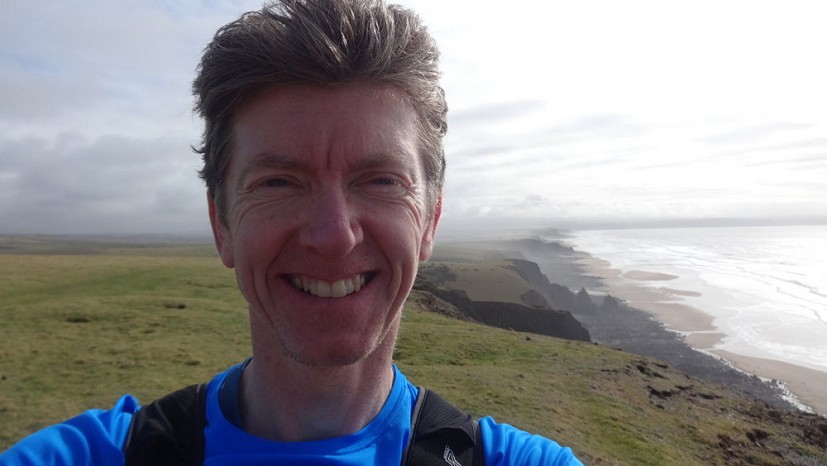
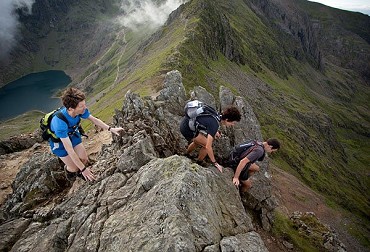
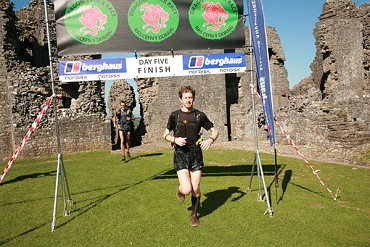
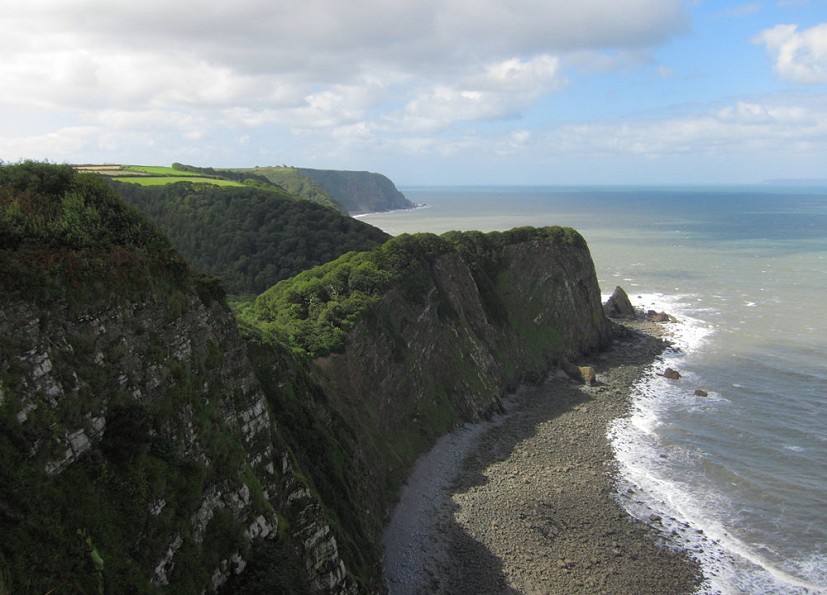



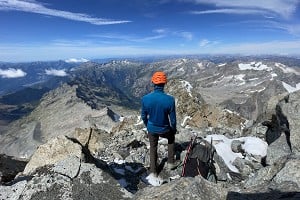
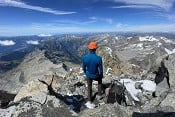


Comments